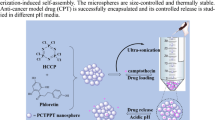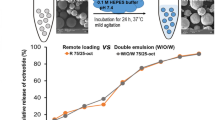Abstract
Purpose. The camptothecin (CPT) analogue, 10-hydroxycamptothecin (10-HCPT) has been shown previously to remain in its acid-stable (and active) lactone form when encapsulated in poly(lactide-co-glycolide) (PLGA) microspheres (1). The purpose of this study was to determine the principal mechanism(s) of 10-HCPT stabilization.
Methods. CPTs were encapsulated in PLGA 50:50 microspheres by standard solvent evaporation techniques. Microspheres were eroded in pH 7.4 buffer at 37°C. The ratio of encapsulated lactone to carboxylate was determined by HPLC as a function of time, initial form of drug encapsulated, fraction of co-encapsulated Mg(OH)2, CPT lipophilicity, and drug loading. Two techniques were developed to assess the microclimate pH, including: i) measurement of H+ content of the dissolved microspheres in an 80:20 acetonitrile/H2O mixture and ii) confocal microscopy of an encapsulated pH-sensitive dye, fluorescein.
Results. The encapsulated carboxylate converted rapidly to the lactone after exposure to the release media, indicating the lactone is favored at equilibrium in the microspheres. Upon co-encapsulation of Mg(OH)2, the trend was reversed, i.e., the lactone rapidly converted to the carboxylate form. Measurement of -log(hydronium ion activity) (pa*H) of dissolved microspheres with pH-electrode and pH mapping with fluorescein revealed the presence of an acidic microclimate. From the measurements of H+ and water contents of particles hydrated for 3 days, a microclimate pH was estimated to be in the neighborhood of 1.8. The co-encapsulation of Mg(OH)2 could both increase the pa*H reading and neutralize pH in various regions of the microsphere interior. Varying the drug lipophilicity and loading revealed that the precipitation of the lactone could also stabilize CPT.
Conclusions. PLGA microspheres prepared by the standard solvent evaporation techniques develop an acidic microclimate that stabilizes the lactone form of CPTs. This microclimate may be neutralized by co-encapsulating a base such as Mg(OH)2, as suggested by previous work with poly(ortho esters) (2).
Similar content being viewed by others
REFERENCES
A. Shenderova, T. G. Burke, and S. P. Scwendeman. Stabilization of 10-hydroxycamptothecin in poly(lactide-co-glycolide) microsphere delivery vehicles. Pharm. Res. 14:1406–1414 (1997).
J. Heller. Development of poly(orto esters): a historical overview. Biomaterials 11:659–665 (1990).
P. K. Gupta, C. T. Hung, and F. C. Lam. In A. Rolland (ed), Pharmaceutical Particulate Carriers: Therapeutic Applications, Marcel Dekker, New York, 1993, pp. 135–165.
J. H. Anderson, C. S. McArdle, and T. G. Cooke. In N. Willmott and J. M. Daly (eds), Microspheres and Regional Cancer Therapy; CRC Press, Boca Raton, 1994, pp. 57–70.
J. Fassberg and V. J. Stella. A kinetic and mechanistic study of the hydrolysis of camptothecin and some analogues. J. Pharm. Sci. 81:676–684 (1992).
R. H. Hertzberg, M. J. Caranfa, K. G. Holden, D. J. Jakas, G. Gallagher, M. R. Mattern, S. Mong, J. O. Bartus, R. K. Johnson, and W. D. Kingsbury. Modification of the hydroxy lactone ring of camptothecins: inhibition of mammalian topoisomerase I and biological activity. J. Med. Chem. 32:715–720 (1989).
S. M. Li, H. Garreau, and M. Vert. Structure-property relationships in the case of the degradation of massive aliphatic poly-(α-hydroxy acids) in aqueous media. J. Mater. Sci. Mater. Med. 1:123–130 (1990).
S. P. Schwendeman, M. Cardamone, H. R. Bvandon, A. Klibanov, and R. Langer. Stability of proteins and their delivery from biodegradable polymer microspheres. In S. Cohen and H. Bernstein (eds.), Microparticulate Systems for the Delivery of Proteins and Vaccines, Marcel Dekker, New York, 1996, pp. 1–49.
P. Burke. Determination of internal pH in PLGA microspheres using 31P NMR spectroscopy. Proceed. Intern. Symp. Control. Rel. of Bioact. Mater. 23:237, (1996).
T. G. Park, W. Lu, and G. Grotts. Importance of in vitro experimental conditions on protein release kinetics, stability and polymer degradation in protein encapsulated poly(D,L-lactic acid-co-glycolic acid) microspheres. J. Contr. Rel. 33:211–222 (1995).
A. Shenderova, T. G. Burke, and S. P. Schwendeman. Characterization of the microclimate in PLGA microspheres with a camptothecin probe. Pharm. Res. 9:S–254 (1996).
D. D. Perrin and B. Dempsey. Buffers for pH and metal ion control, Chapman and Hall, New York, 1987.
R. G. Bates, M. Paabo, and R. A. Robinson. Interpretation of pH measurements in alcohol-water solvents. J. Phys. Chem. 67:1833–1838 (1963).
R. G. Bates. Determination of pH. Theory and Practice, A Wiley-Interscience Publication, New York, 1973.
G. Douheret. Potentiels de jounction liquide et effet de milieu en solvants mixtes eau-solvant aprotique dipolaire. Bull. Soc. Chim. France 8:3122–31 (1968).
Y. Zhang, S. Zale, L. Alukonis, and H. Bernstein. Effects of metal salts on PLGA hydrolysis. Proceed. Intern. Symp. Control. Rel. Bioact. Mater. 22:83–84 (1995).
T. G. Park. Degradation of poly(D,L-lactic acid) microspheres: effects of molecular weight. J. Contr. Rel. 30:161–173 (1994).
T. French, P. T. C. So, D. J. Weaver Jr., T. Coelho-Sampaio, E. Grattton, E. W. Voss Jr., and J. Carrero. Two-photon fluorescence lifetime imaging microcopy of macrophage-mediated antigen processing. J. Microscopy 185:339–353 (1997).
S.-C. Chen, H. Nakamura, and Z. Tamura. Supplemental studies on relationships between structure and spectrum of fluorescein. Chem. Pharm. Bull. 27:475–479 (1979).
T. G. Burke, A. K. Mishra, M. C. Wani and M. E. Wall. Lipid bilayer partitioning and stability of camptothecin drugs. Biochemistry 32:5352–5364 (1993).
J. T. Carstensen. Drug stability: principles and practices, Dekker, New York, 1995.
Author information
Authors and Affiliations
Corresponding author
Rights and permissions
About this article
Cite this article
Shenderova, A., Burke, T.G. & Schwendeman, S.P. The Acidic Microclimate in Poly(lactide-co-glycolide) Microspheres Stabilizes Camptothecins. Pharm Res 16, 241–248 (1999). https://doi.org/10.1023/A:1018876308346
Issue Date:
DOI: https://doi.org/10.1023/A:1018876308346




